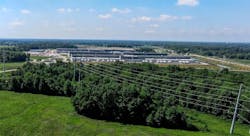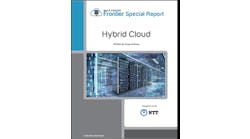As data center developers scramble to find enough land and power to support their new MegaCampuses, Central Ohio has become a focal point for new digital infrastructure.
The Ohio cloud cluster has grown over the last decade, as three large cloud companies chose New Albany, a suburb of Columbus, as the home for their new data centers. Things kicked into a different gear in 2023 with a burst of land banking by hyperscale operators and data center developers.
These land purchases lay the groundwork for years of data center development in the region, with hyperscalers expanding their operations, and being joined by a new wave of multi-tenant REITs (real estate investment trusts).
“Ohio is establishing itself as a premier destination for technology investment,” said Ohio Lieutenant Governor Jon Husted. “And it further strengthens our case that Ohio is becoming the tech capital of the Midwest.”
Ohio is among the regions seeing a strong uptick in activity as leading markets encounter constraints on the availability of power, a trend we have been tracking for several years here at DCF.
This has prompted developers to look beyond historic hot spots like Northern Virginia, Silicon Valley, Dallas and Chicago in their site selection process.
The early winners have been secondary markets with available utility power that are already familiar to hyperscale tenants. That cohort includes Hillsboro (Oregon), Salt Lake City, Austin and Atlanta as well as Central Ohio.
As land banking absorbs prime parcels in these familiar markets, developers are seeking growth in other secondary markets, including some new destinations for hyperscale development.
Building a Silicon Heartland
The influx of data center projects is part of a larger economic growth story in Central Ohio. Intel is investing up to $20 billion to build two chip fabrication plants on a 1,000-acre site in New Albany. The project is the largest in Ohio history and is expected to attract additional players in the chip infrastructure, creating a “Silicon Heartland.”
That’s one of the reasons why data center companies moved so aggressively to lock down a path for future growth in the region. In some active real estate markets, data center developers are competing for land deals with other industrial buyers, notably logistics and warehouse companies.
New Albany offers a combination of features that have made it irresistible to the Internet economy, including a 765 kVA power transmission system operated by utility AEP and the ability to choose power providers.
The region also has excellent access to a key fiber backbone that connects cloud campuses across the US. This video by the City of New Albany provides a closer look at the projects by AWS, Meta and Google.
Here’s a look at the flurry of market entrants and expansions by existing players in the Central Ohio data center cluster during 2023.
- Cloud titan Amazon Web Services just reached a deal with New Albany officials on a $3.5 billion expansion of its existing campus, which will add five data center buildings totaling 1.25 million square feet of technical space. AWS may also consider expansion at its other sites in Ohio, with an additional total investment estimated at $7.8 billion.
- Google has announced plans to invest $1.7 billion in a trio of campuses in Central Ohio, located in New Albany, Columbus and Lancaster. The new projects expand upon Google’s original New Albany campus, a $600 million project begun in 2019.
- Microsoft has acquired 200 acres in New Albany for a future data center campus.
- QTS Data Centers plans to build four new data centers in New Albany, representing $1.5 billion in investment spread across two campuses, with “rapid, large-scale development.”
- Edged Energy has received approval to build a data center campus in New Albany, investing $250 million for a 210,000 square foot facility.
- Aligned Datacenters has unveiled plans to build 4 data centers on a 129-acre data center campus in Perkins Township, about 100 miles north of Columbus.
- Local media report that Apple is eyeing Ohio for a future data center project, considering joining its hyperscale rivals.
Why Ohio?
The new projects in Ohio are part of the ongoing expansion in the geography of digital infrastructure, which has brought data centers to new places. The Midwest has been a beneficiary of this trend, with data center clusters emerging in Iowa, Nebraska and now Indiana.
During the early days of the Internet, data center development was focused in technology hubs near coastal cities, including Northern Virginia, New York and Silicon Valley. That began to change with the emergence of the hyperscale data center – massive buildings optimized to house tens of thousands of web servers and data storage devices – which placed a premium on an abundance of cheap land and power, including rural locations.
The data center growth in New Albany began in 2014 with Compass Datacenters, which cited strong interest in the region from data center clients. Shortly after, Amazon Web Services built three campuses in the region, and Meta and Google each added a campus in New Albany. Among multi-tenant providers, the area has become a key hub for Cologix, which operates a campus in New Albany.
Locating data centers in the center of the country helps distribute content efficiently, reducing lag and buffering for streaming media like Netflix movies or Facebook videos. It also allows for data to move quickly to either coast, which can be important in application development.
As an example, AWS says its Ohio cloud customers experience just 12 milliseconds of round-trip latency when sending data to US-East, the large cluster of AWS facilities in Northern Virginia. This makes it easier for customers to replicate data for automatic failover when one region has performance problems or an outage.
Historical Links
In addition to its central location, the Ohio cloud cluster also benefits from history. There is a huge concentration of cloud capacity along the 41st parallel, which runs through Ohio, Iowa, Wyoming and Utah.
This route is followed by East-West fiber routes that track railroad rights of way built along the 41st parallel. AT&T, Verizon, Comcast, Level 3, Zayo, Fibertech and Windstream are among the providers with fiber running alongside the original Union Pacific railroad system.
“This fiber optic infrastructure provides the datacenters with unprecedented access to the absolute highest bandwidth in a virtuous cycle of investment: more datacenters drive more traffic, which drives more fiber optic cables, which drives more datacenters,” notes Microsoft’s George Moore, who shared a LinkedIn post on the history of data center development along the 41st parallel.






